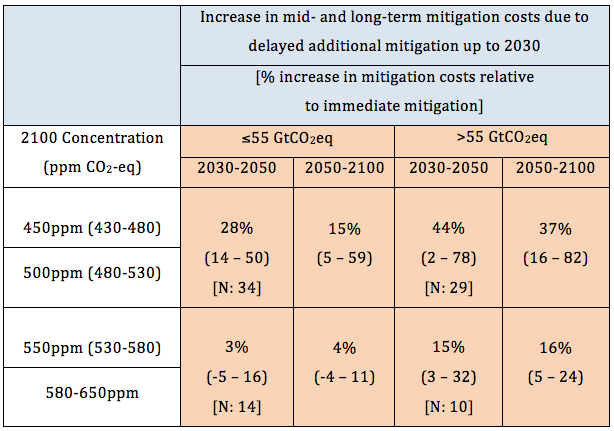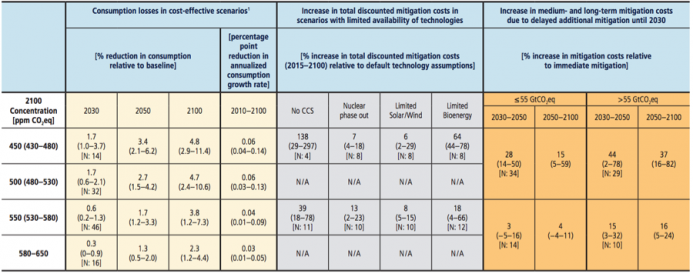Do We Really Have A Decade Left To Solve Climate Change? – OpEd
By MISES
By Robert P. Murphy*
Wise alecks on social media noted with amusement how Beto O’Rourke recently claimed humans had only ten years to act on climate change, thus one-upping Alexandria Ocasio-Cortez who had previously gone out on a limb by putting the deadline at twelve years. Snark aside, it’s important to point out that the “consensus science” as codified, for example, in the periodic reports from the United Nations do not support such a cliff-hanger mentality at all.
Our Political Figures Ignore the IPCC
The quickest way to make this point is to reproduce something I highlighted several years ago in an IER post where I caught Paul Krugman just making up stuff about climate change. Specifically, the following table comes from the latest Intergovernmental Panel on Climate Change (IPCC) report, the AR5 (Table SPM.2):
To make it easier to read, I’ll excerpt the relevant left and right portions of the table below:

There’s a lot of information in the table, but let me summarize the important elements vis-à-vis the recent claims from O’Rourke and Ocasio-Cortez. The beige cells in the adapted table above show the percentage increases in the total (undiscounted) mitigation costs necessary to achieve the far-left (white cells) atmospheric concentrations of greenhouse gases in the year 2100, for the years 2030-2050 and also for 2050-2100, for two different scenarios of total emissions (either below 55 gigatons of CO2-equivalent, or above).
In other words, the beige cells show us how much a delay of government action through the year 2030 will increase the cost necessary to achieve the specified atmospheric concentrations for the year 2100 (white cells). Specifically, the beige cells show that by “doing nothing” about climate change until the year 2030, even in a high-emission baseline scenario, the IPCC’s best guess of the cost of achieving the aggressive outcome rises by 44 percent in the years 2030-2050 and 37 percent in the years 2050-2100.
Now to be sure, the rhetorical point of the above table in the AR5 was to encourage support for climate mitigation policies. The people who put together this table for policymakers wanted to show, “Hey, since we’re obviously going to have to deal with climate change eventually, we might as well get going, because the longer we delay, the more expensive it will be.”
IPCC: An Inconvenient Truth
My modest point here, however, is to show that this table now poses an awkward stumbling block for those—like O’Rourke and Ocasio-Cortez—trying to scare people into supporting ludicrously expensive and aggressive proposals to “fight climate change.” If O’Rourke and Ocasio-Cortez were anywhere close to being correct when issuing their ever-shrinking windows for action, then in the IPCC table above, the beige cells should have all had infinity signs, and in a footnote it would explain: “If we wait until 2030 to begin mitigation efforts, we will all die.”
But that’s not what the UN report told us. Instead, it reported that yes, the costs of achieving various climate targets (as measured by atmospheric concentrations of CO2 in the year 2100) would be higher due to delay, but even in a pessimistic scenario, the best-guess of the cost increase was 44 percent.
Conclusion
In this article, I highlighted one particular table from the most recent UN report on the science of climate change in order to show just how baseless are the recent claims that humans have x years to act on climate change. Over at Reason, Ronald Bailey marshals more evidence—again, from the very “consensus science” documents we are supposed to rely on—to show that these claims are nonsense.
This whole episode is yet another example demonstrating the farce of the climate change policy debate. Whenever a critic disagrees with the most radical proposals that would—according to their own proponents—transform Western society, the critic is berated as a science denier. And yet, even a cursory examination of the actual technical reports shows that the prophets of doom are the ones who are spouting forth unsupported claims.
Originally published at the Institute for Energy Research
About the author: Robert P. Murphy is a Senior Fellow with the Mises Institute and Research Assistant Professor with the Free Market Institute at Texas Tech University. He is the author of many books. His latest is Contra Krugman: Smashing the Errors of America’s Most Famous Keynesian. His other words include Chaos Theory, Lessons for the Young Economist, and Choice: Cooperation, Enterprise, and Human Action (Independent Institute, 2015) which is a modern distillation of the essentials of Mises’s thought for the layperson. Murphy is co-host, with Tom Woods, of the popular podcast Contra Krugman, which is a weekly refutation of Paul Krugman’s New York Times column. He is also host of The Bob Murphy Show.
Source: This article was published by the MISES Institute


